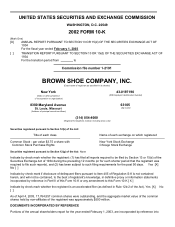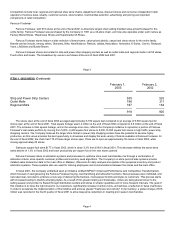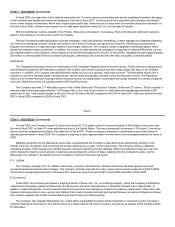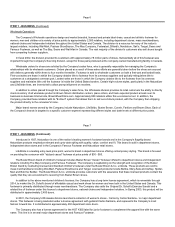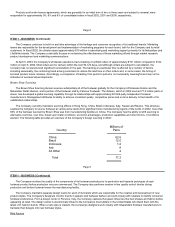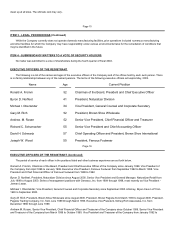Famous Footwear 2003 Annual Report Download - page 8
Download and view the complete annual report
Please find page 8 of the 2003 Famous Footwear annual report below. You can navigate through the pages in the report by either clicking on the pages listed below, or by using the keyword search tool below to find specific information within the annual report.
Customer Concentration
The customers of the Company's wholesaling business include department stores and mass merchandisers. Several of the
Company's customers control more than one department store and/or mass merchandiser chain. While the Company believes purchasing
decisions in many cases are made independently by each department store or mass merchandiser chain under such common ownership, a
decision by the controlling owner of a group of department stores and/or mass merchandisers, or any other significant customer, to decrease
the amount of footwear products purchased from the Company could have a material adverse effect on the Company's business, financial
condition or results of operations.
In addition, the retail industry has periodically experienced consolidation and other ownership changes, and in the future the Company's
wholesale customers may consolidate, restructure, reorganize or realign, any of which could decrease the number of stores that carry the
Company's products.
Intellectual Property Risks
The success of the Company's Wholesale division has to date been due, in part, to the Company's ability to attract licensors which have
strong, well-recognized characters and trademarks. The Company's license agreements are generally for an initial term of two to three years,
subject to renewal, but even where the Company has longer term licenses or has an option to renew a license, such license is dependent
upon the Company's achieving certain results in marketing the licensed material. While the Company believes its relationships with its
existing licensors are good and it believes it will be able to renew its existing licenses and obtain new licenses in the future, there can be no
assurance the Company will be able to renew its current licenses or obtain new licenses to replace lost licenses. In addition, certain of the
Company's license agreements are not exclusive and new or existing competitors may obtain similar licenses.
Page 12
The Company believes that its trademarks and tradenames are important to its business and are generally sufficient to permit it to carry
on its business as presently conducted and planned. The Company cannot, however, know whether it will be able to secure protection for its
intellectual property in the future or if that protection will be adequate for future operations. Further, the Company faces the risk of ineffective
protection of intellectual property rights in jurisdictions where it sources and distributes its products. The Company also cannot be certain that
its activities do not infringe on the proprietary rights of others. If the Company is compelled to prosecute infringing parties, defend its
intellectual property, or defend itself from intellectual property claims made by others, it may face significant expenses and liability.
Dependence on Major Branded Suppliers
The Company's Famous Footwear retail business purchases a substantial portion of its footwear products from major branded
suppliers. While the Company believes its relationship with its existing suppliers is good, the loss of any of its major suppliers could have a
material adverse effect on the Company's business, financial condition or results of operations. As is common in the industry, the Company
does not have any long-term contracts with its suppliers. In addition, the success of the Company's financial performance is dependent on
the ability of Famous Footwear to obtain product from its suppliers on a timely basis and on acceptable terms.
Litigation and Other Regulatory Proceedings
We are a defendant from time to time in lawsuits and regulatory actions relating to our business. As more fully set forth in Item 3 of this
annual report on Form 10-K, these include, among others, a pending class action lawsuit in Colorado relating to alleged environmental
contamination. Due to the inherent uncertainties of litigation and regulatory proceedings, the Company cannot accurately predict the ultimate
outcome of any such proceedings. An unfavorable outcome could have a material adverse impact on the Company's business, financial
condition and results of operation. In addition, regardless of the outcome of any litigation or regulatory proceedings, such proceedings are
expensive and will require that we devote substantial resources and executive time to defend the Company.
Available Information
Our Internet address is www.brownshoe.com. Our Internet address is included in this annual report on Form 10-K as an inactive textual
reference only. The information contained on our website is not incorporated by reference into this annual report on Form 10-K and should not
be considered part of this report. We file annual, quarterly and current reports, proxy statements and other information with the Securities and
Exchange Commission (SEC). We make available free of charge our annual report on
Page 13

